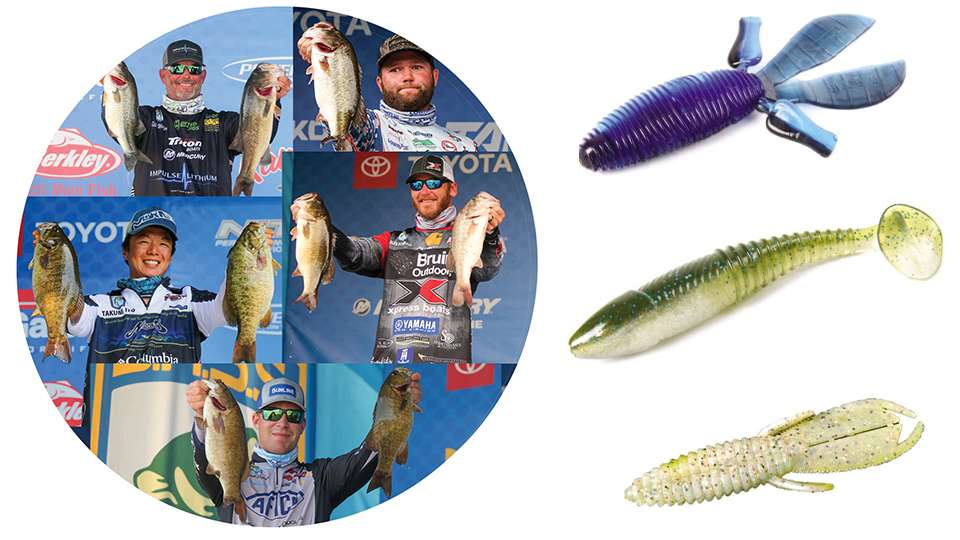
With much of the nation settling into summer patterns, or shortly on the way, the year’s sixth month offers plenty of giant bite opportunities. Fooling these heavyweights requires situational awareness and the discipline to make the most of every bite. Here’s how the Bassmaster Elite Series pros get it done.
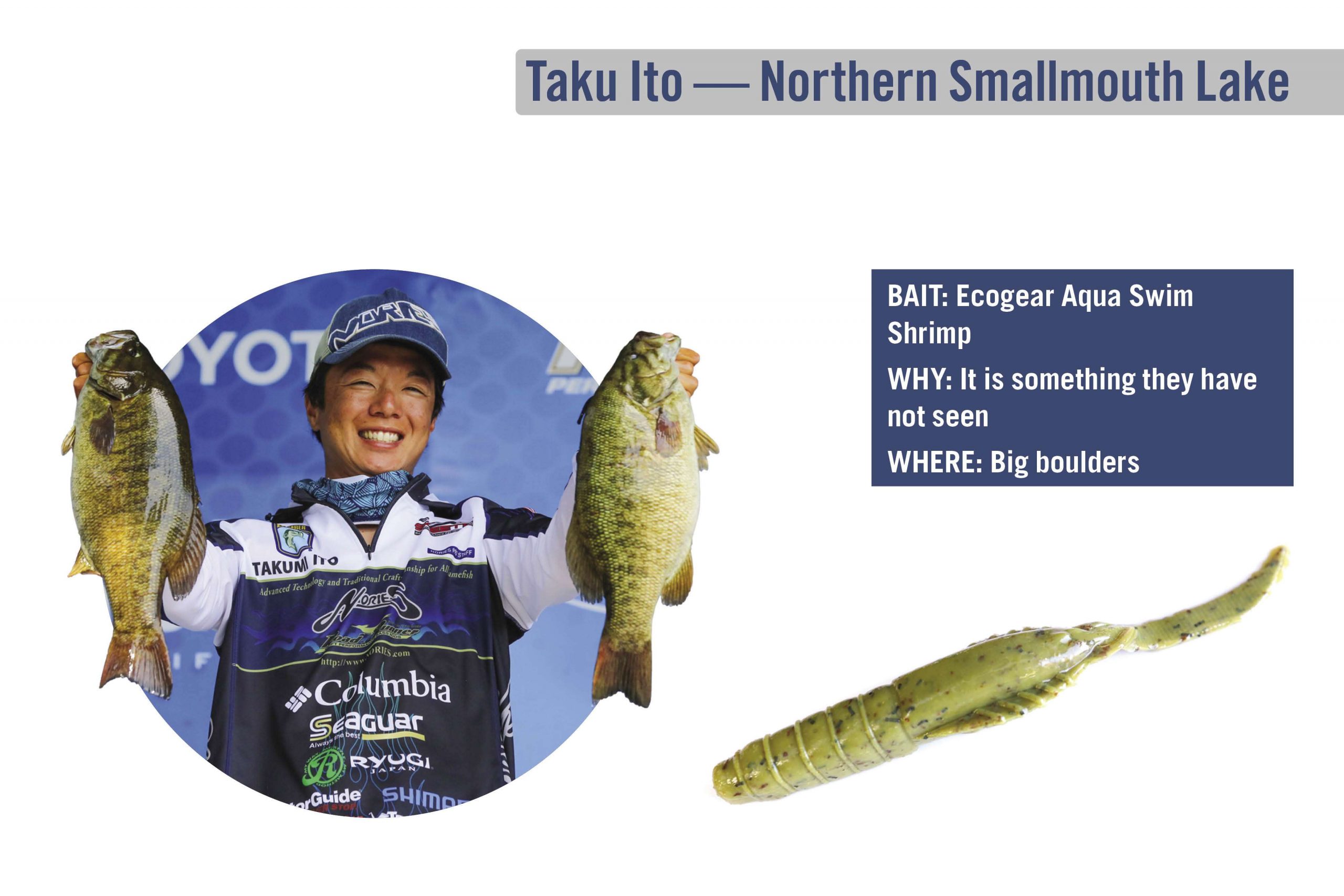
Taku Ito — Northern Smallmouth Lake
Even though he’d never caught smallmouth prior to 2020, earning three Top 10s during the Northern Swing proved Ito’s wheelhouse holds the tools to tempt whopper bronzebacks. The key for him was tapping into the dynamic yet patient mindset needed to fool heavily pressured largemouth in his Chiba, Japan, home waters of the Tone River and Lake Kameyama.
Ito’s game starts with singling out the jumbos: “I think there are two types of smallmouth: One type of fish is moving everywhere, and they don’t have a specific habitat. The other type of fish [positions] near big rocks, and those fish don’t [school].”
Noting that the latter scenario typically holds the big ones, Ito said he’ll look for isolated boulders about the size of a bass boat. A slam dunk this is not, but a patient, persistent approach — often returning multiple times to the giant spot — may reward him with a mound of brown.
“I think it depends on timing; wind and [barometric] pressure changes will make the fish bite,” Ito said. “It’s also important to keep your distance [from giant smallmouth] and change the lure often.”
In last year’s Northern events, Ito often had to show his biggest smallmouth several looks by rotating through as many as 10 different baits. He fared best with the 3 1/2-inch Nories Lady Fish, a 2-inch Ecogear Rock Claw and a 4-inch Ecogear Aqua Swim Shrimp.
“I’m not changing my lure by the fish size, but I will use many lures for catching the smallmouth bass,” Ito said. “Sometimes ‘shaking’ was good, but other times, ‘staying’ was good. I think it’s very important that I’m not lazy.”
When a giant committed, Ito followed a simple but effective capture strategy: “Loosen the drag as much as possible and fight the fish slowly. That’s my style!”
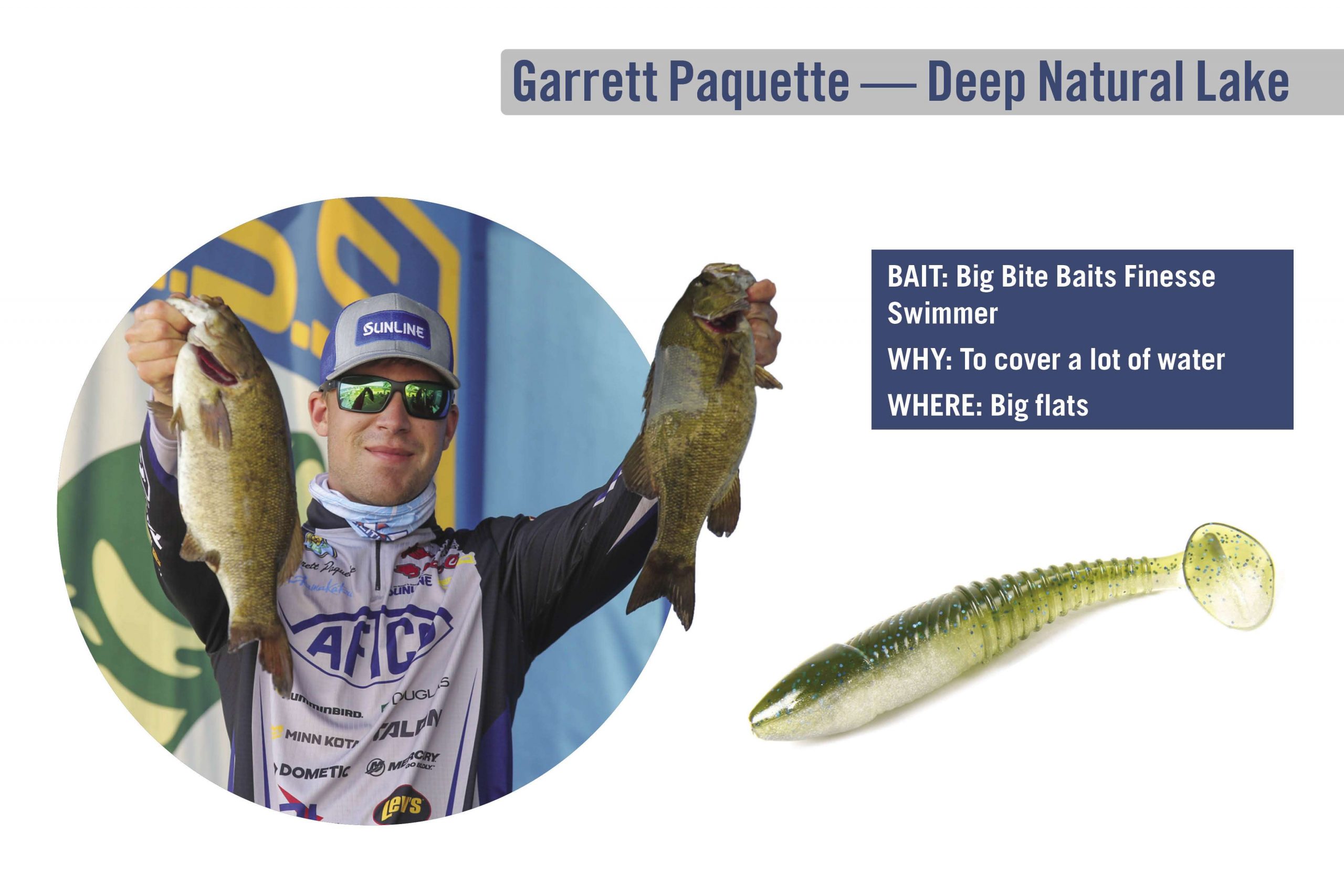
Garrett Paquette — Deep Natural Lake
June is still spawning time up north and Michigan pro Garrett Paquette knows that, while he can often find several respectable male smallmouth on beds, it’s important to avoid preoccupation with lesser opportunities. The fact is, large postspawn females will be lazing around the big flats with isolated boulders adjacent to the spawning areas.
“Those 6- to 7-pound females will move up, lay their eggs, then sit over those deep spots in 10 to 20 feet of water,” Paquette said. “They just roam around real lazy like. They’re not always the easiest fish to catch, because they’re in that postspawn mood, but the guy that can stay really patient and fish thoroughly has a chance at catching those fish.”
Paquette fares best by slow rolling a ball-head jig with a 3.4-inch Big Bite Baits Finesse Swimmer. He’ll use a 1/4-ounce jig for up to 12 feet of water and increase to a 3/8-ounce for deeper spots.
For optimal presentation, Paquette throws his swimbait on a 7-4 spinning rod and allows himself the necessary partnership of strength, sensitivity and stealth by spooling with 12-pound braid and adding about 10 to 15 feet of 8-pound fluorocarbon leader.
“Usually, the longer the leader, the better, so those fish can’t see your braid,” Paquette said. “Also, it gives you some good stretch. When you’re fighting a big smallmouth on light line, the more fluorocarbon you have, the more shock absorbance you have, and that minimizes break-offs.”
Paquette said the requisite postspawn presentation may test your patience, but speed kills. The fish that readily chased a swift bait a couple of weeks ago will roll their eyes at the fast stuff during this postspawn period. But, if you make it easy on them, they’re more likely to open their mouths.
“I’ll throw that bait as far as I can, let it sink to the bottom and just slowly reel it back in so it’s about 6 inches to a foot off the bottom,” Paquette said. “I’ll occasionally let it hit the bottom, but it’s mostly a slow, steady retrieve, covering lots of water.”
Just don’t spend too much time in the basement, Paquette advised. “I’m not dredging the bottom like in spring; I’m just occasionally making contact. The grass will be growing by then, so you don’t want to gunk up your bait.”
Bites are subtle — something like a worm bite — so Paquette stays alert for the tick and simply lets the fish load the rod. No need for a jaw-jacking hook set — just speed up the reeling cadence, sweep into ’em and let the drag do the work.

Caleb Sumrall — Tidal Fishery
The Elite pro from New Iberia, La., can be as intricate as the next guy, but he knows June is not the time for frivolities. In weedy tidal waters like those of his southern Louisiana stomping grounds, Sumrall’s keen on punching his way to a big bite.
“I’ll punch the heaviest mats I can find near current,” Sumrall said. “I want moving water, stained water or anywhere I think it may be cooler. I avoid dead ends or the backs of pockets where the water may be really hot.
“There may not be a way to pattern big fish by punching, but I feel like if you concentrate on being around fish, you’ll run into a big one.”
Sumrall tries to increase his likelihood of running into a day-maker by leveraging every positional detail to his favor. That starts with a hard edge bank where the fish can settle, but nothing with water reaching into inaccessible woods.
“I prefer a windblown bank because that [encourages fish] to position on the edge of the mat, facing out for feeding,” Sumrall said. “They can stay under cover and catch anything that swims by without having to leave. I rarely catch one dead in the center of a mat.”
For time efficiency, Sumrall prefers a smaller mat, and he’ll focus on any cuts and points that a big fish will claim. If the mat holds a laydown, that’s money.
“My No. 1 punching bait is a Missile Baits D Bomb on a 4/0 Gamakatsu flipping hook with a pegged Kajun Boss tungsten weight,” Sumrall said. “If a fish is shallow under a mat in June, they’re eating bream, so I use green pumpkin or candy grass colors — and I dip the tails in chartreuse.”
Sumrall wants the lightest weight that will penetrate the mat without having to fight the bait through. He starts with the full-size D Bomb, but downsizing to the Baby version may help breach the mat without increasing his weight.
“Efficiency is key; you want your bait to go in and out as your boat goes by,” he said. “You want to make four to five more casts than the next guy, so you don’t want to be fighting with the mat. You want your bait to drop fast and surprise them.”
If they don’t bite on the fall, Sumrall will pull his bait to the mat’s underside for just a couple of seconds. Offering a different look may close the deal. He knows if he covers enough water, he’ll get his shots at difference-makers.
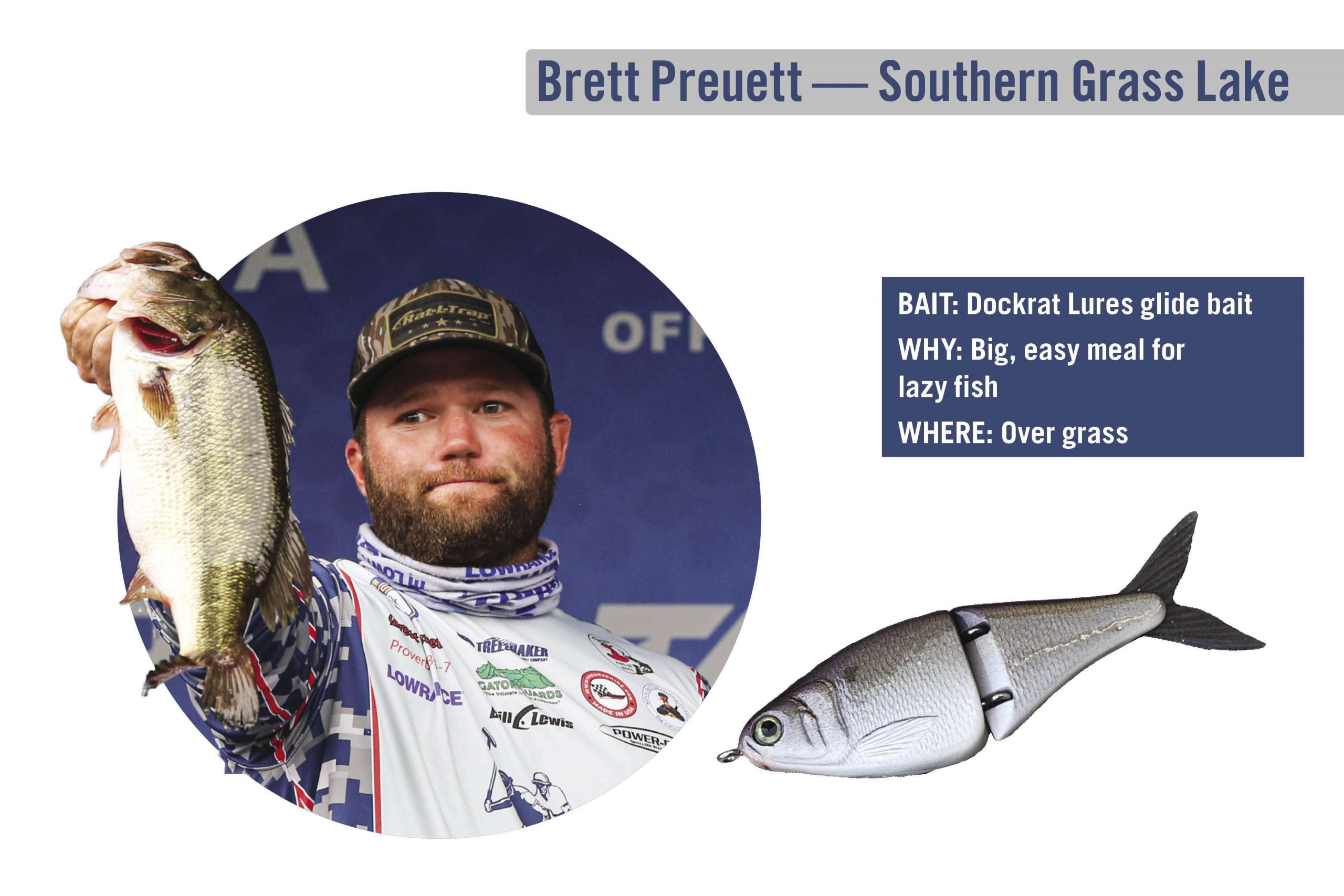
Brett Preuett — Southern Grass Lake
On the familiar waters of northwest Louisiana’s Caney Lake, Preuett has perfected a technique he’s confident will tempt the giants roaming almost any grassy habitat: glide baiting over the vegetation.
“They’re just sitting down in that hydrilla, looking for a big meal,” Preuett said. “You might only get two or three bites — or maybe one bite — all day, but I’ve caught some really big fish doing that.”
Preferring an 8-inch 3:16 Lure Company Work Horse or a Dockrat Lures glide bait, Preuett retrofits his baits with Size 1 Gamakatsu Aaron Martens TGW Finesse Trebles. If bites are noncommittal and he’s having trouble hooking fish, he’ll add another split ring between the original ring and the hook hanger. Lowering the hook, Preuett said, often improves his success.
Preuett said he’s usually working this technique in 6 to 10 feet of water. Sufficient clearance over the grass is key for allowing the glide bait room to work, but without 2 to 3 feet of visibility, Preuett knows his chances are slim.
“This can be an all-day thing, but I’ve had the most bites in the first hour of the morning,” Preuett said.
A 7-11 Shimano Expride rod with a Shimano Curado 300 carrying 20-pound Sunline Assassin fluorocarbon allows Preuett the generous casting distance befitting the glide-bait presentation. Stay alert, he said, as big bites often come at the end of a long toss.
“I try to stop the bait two times during the cast, because there’s often a follower, and that may be the trigger,” Preuett said. “A little pause makes that bait turn and look back at the fish, and that’s when they eat it.”
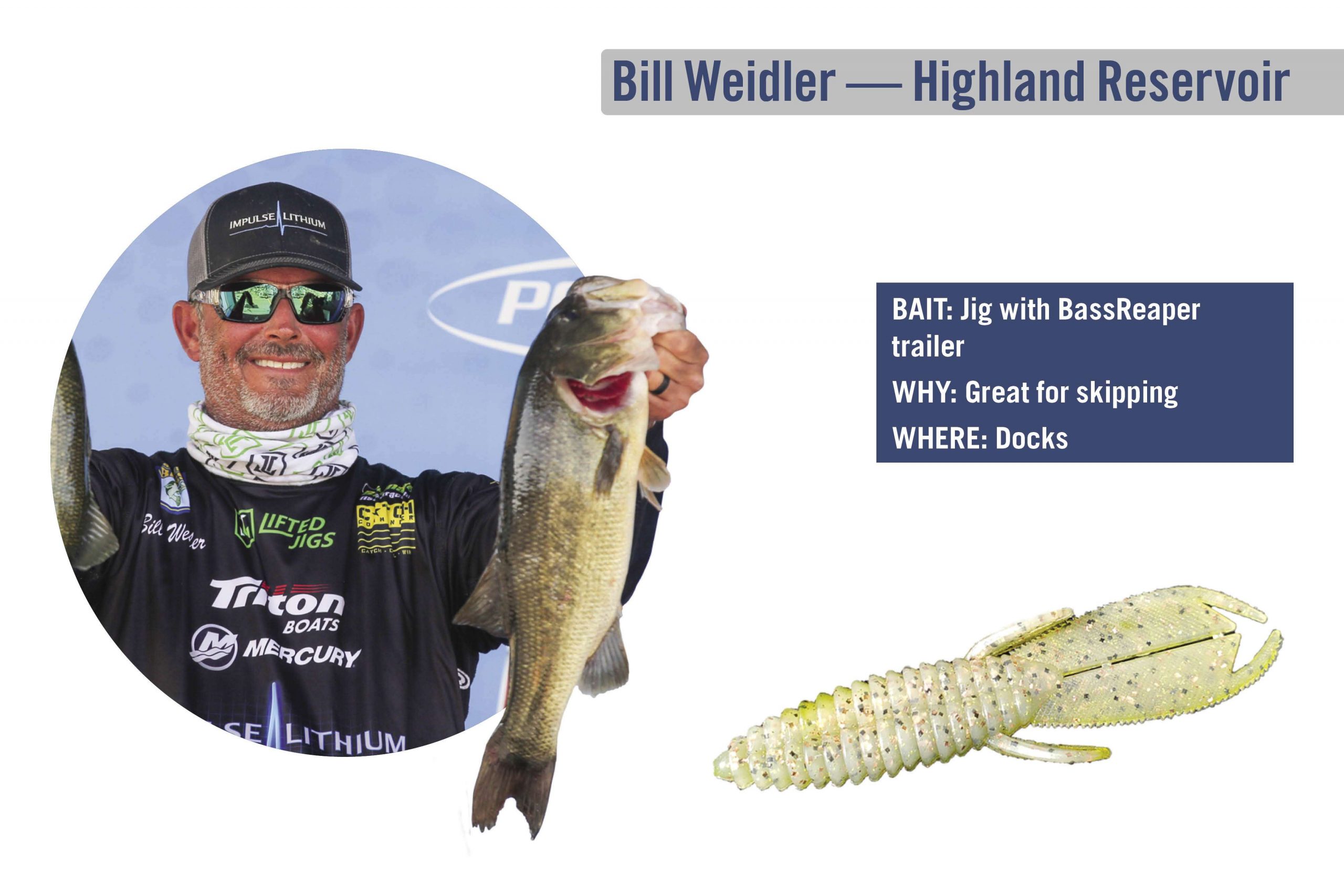
Bill Weidler — Highland Reservoir
Using Smith Lake as an example, Weidler believes his best bet for a June giant awaits in the shady cover of deep docks. He’ll focus on creek mouths or main-lake structures in at least 10 feet of water.
Weidler’s confident he can get bit on a big shaky head, but he’ll lean more toward a 1/2-ounce green pumpkin Lifted Jigs flipping jig with a matching
4 1/4-inch BassReaper Bait Company Contagion trailer. Given the fairly clean habitat into which he’ll send his jig, Weidler will thin about one-quarter of the weedguard strands and fan the rest for easier hook penetration.
“When you’re flipping docks, you’re really not in any heavy cover,” Weidler said.
Weidler starts about halfway back on a dock and hits it from multiple angles. He’ll mix up a traditional in-and-out pitching presentation with a dragging look.
“I’ll go parallel with the bank, as well as perpendicular,” Weidler said. “Sometimes they set up differently and they may want to eat with the bait coming a different way. If there’s current, I always pitch it into the current and bring it back.”
Dock duty’s no joke, so Weidler arms himself with a 7-5 heavy Temple Fork Outfitters rod and an 8:1 reel that allows him to quickly gather line for follow-up shots. In clear water, he uses 20-pound fluorocarbon, but if the lake has any stain, it’s 50-pound braid.
“The heavier line gives you a lot of strength, and working with the rod flex, it’s usually enough,” Weidler said. “When you’re in dock-flipping mode, you’re going into battle.”
Weidler locks down his drag for dock combat and relies on the proper rod action for the heavy work. When the giant quest comes to fruition, he offers this advice: Hold tight.
“When you hook a 6-pound fish that’s 5 feet in front of you, it’s game on!”
Originally appeared in Bassmaster Magazine 2021.





